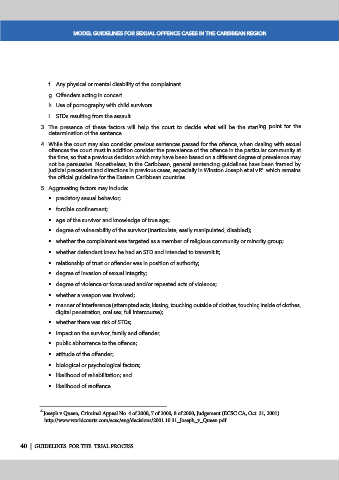Page 639 - Magistrates Conference 2019
P. 639
MODEL GUIDELINES FOR SEXUAL OFFENCE CASES IN THE CARIBBEAN REGION
f. Any physical or mental disability of the complainant.
g. Offenders acting in concert.
h. Use of pornography with child survivors.
i. STDs resulting from the assault.
3. The presence of these factors will help the court to decide what will be the starting point for the
determination of the sentence.
4. While the court may also consider previous sentences passed for the offence, when dealing with sexual
offences the court must in addition consider the prevalence of the offence in the particular community at
the time, so that a previous decision which may have been based on a different degree of prevalence may
not be persuasive. Nonetheless, in the Caribbean, general sentencing guidelines have been framed by
4
judicial precedent and directions in previous cases, especially in Winston Joseph et al v R which remains
the official guideline for the Eastern Caribbean countries.
5. Aggravating factors may include:
• predatory sexual behavior;
• forcible confinement;
• age of the survivor and knowledge of true age;
• degree of vulnerability of the survivor (inarticulate, easily manipulated, disabled);
• whether the complainant was targeted as a member of religious community or minority group;
• whether defendant knew he had an STD and intended to transmit it;
• relationship of trust or offender was in position of authority;
• degree of invasion of sexual integrity;
• degree of violence or force used and/or repeated acts of violence;
• whether a weapon was involved;
• manner of interference (attempted acts, kissing, touching outside of clothes, touching inside of clothes,
digital penetration, oral sex, full intercourse);
• whether there was risk of STDs;
• impact on the survivor, family and offender;
• public abhorrence to the offence;
• attitude of the offender;
• biological or psychological factors;
• likelihood of rehabilitation; and
• likelihood of reoffence.
4 Joseph v Queen, Criminal Appeal No. 4 of 2000, 7 of 2000, 8 of 2000, Judgement (ECSC CA, Oct. 31, 2001).
http://www.worldcourts.com/ecsc/eng/decisions/2001.10.31_Joseph_v_Queen.pdf
40 | GUIDELINES FOR THE TRIAL PROCESS

